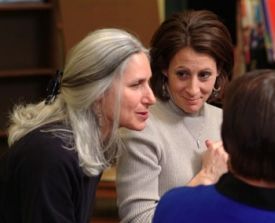Professional Development for Teachers
PD WORKSHOPS for classroom teachers, reading specialists, special education teachers, administrators, librarians, museum educators
All workshops can be tailored to your specific curriculum and teaching needs within your available time frame. Most workshops can be presented in a 2 1/2 or 3 hour format. More in-depth material will be covered during a full day training or in multiple sessions.
When possible, teachers are encouraged to try out these techniques in their classrooms, and share their questions, observations, and experiences at a follow-up session. Written lesson plans, bibliographies and a music resource list will be made available to all participants. No previous movement experience is necessary.



WORKSHOPS
BEYOND PAPER AND PENCIL: Bringing the Curriculum to Life through Movement (K-5)
Children love to move! By engaging students’ kinesthetic intelligence, teachers can help them learn reading skills, history and social studies, science and math concepts, and English language arts. This participatory workshop will give teachers tools to use accessible, movement-based learning activities to deepen learning and teach curriculum aligned with the Common Core State Standards. Special attention will be paid to supporting the needs of children with short attention spans or diverse learning styles, through the use of creative movement activities designed to help children refocus and unlock their natural learning abilities. Through movement, disruptive fidgeting can be channeled into constructive learning that engages students and brings joy to the classroom. Classroom management techniques, and the use of music and props will also be included.
WORDS THAT MOVE US: Teaching Language Arts Kinesthetically (K-5)
“Movement is an indispensable part of learning and thinking,” according to neurophysiologist Dr. Carla Hannaford. Teachers will learn a variety of movement strategies to bring reading comprehension, vocabulary, punctuation, grammar, and other ELA skills to life. Activities may include: improvising to a story, making a tableau to show the main idea of a poem, creating shapes and gestures to analyze punctuation, choreographing group movements to show the definition of words, and movement games to replace worksheets. Kinesthetic teaching makes learning visible to allow for immediate assessment. A bibliography, classroom management techniques, and the use of music and props will also be included.
MINDS IN MOTION: Making The Link Between Creative Movement and Science (K-5)
Science is the story of the physical world. What better way to understand it than through our physical bodies? Creative movement is a physical language that can help make science highly accessible to elementary school children. This workshop equips educators to use dance elements, improvisation, journeys, tableau and choreography to teach basic concepts and information. Participants will be led through actual movement lessons chosen from among the following: life cycles and transformation, sound waves, body systems, habitats, weather, astronomy, and more.
THE DANCE OF NUMBERS: Teaching Mathematics through Movement (K-4)
Creative movement can help students construct a concrete experience of abstract mathematical operations. This hands-on workshop equips teachers with simple, engaging movement and dance activities to teach the concepts of multiplication and division, drill multiplication tables, practice multi-step multiplication, experience common factors, and unlock the secret of mixed fractions through rhythm and choreography. There will even be an order-of-operations dance for long division!
EARLY CHILDHOOD: Using Movement to Enhance Student Learning
Young children are always moving! This participatory course demonstrates engaging strategies that can integrate movement — children’s natural language — into the early childhood curriculum in schools and other settings. Using scarves, songs, music, and children’s literature, we will explore how kinesthetic teaching techniques provide a springboard for the development of body and group awareness, spatial and numerical concepts, language and pre-reading skills. Creative movement activities can ease transitions and classroom management issues as they heighten self-esteem, nurture creativity, and build community in the classroom.
Embodying Art: Entering the Visual Arts through Creative Movement (K-4)
Children love to move, yet they can often become timid with space and motion as they paint and draw. This participatory workshop will introduce art teachers to accessible movement-based teaching strategies to help children learn about color, line and form. Activities will include:
The Great Blueness by Arnold Lobel (color and mood), and Little Green by Keith Baker (line)
Action poses and moving group body sculptures
Tableau to represent art concepts and “climb inside” well-known paintings
A shadow screen
Creating a color wheel “square dance”
Watch Susan presenting at a New York State United Teachers professional development workshop for primary school teachers in 2015:
[/vc_column_text][/vc_column][vc_column width=”1/6″][/vc_column][/vc_row]